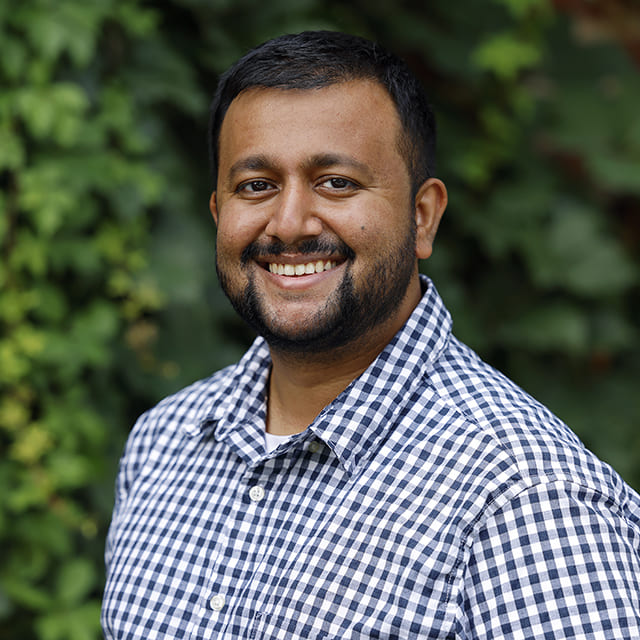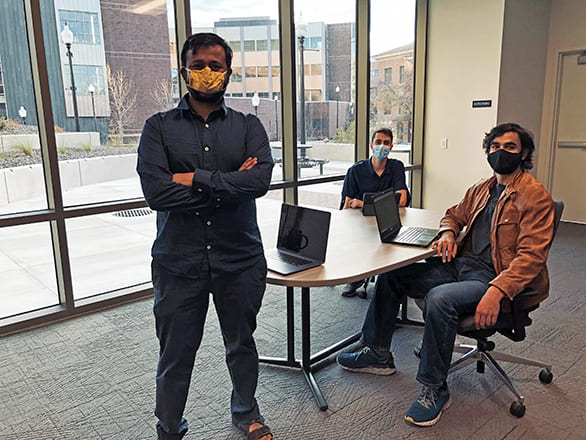When faced with the challenges associated with the coronavirus pandemic, a group of elected officials, doctors, medical professionals, data scientists, and public relations specialists from across the Truckee Meadows region developed the Truckee Meadows COVID Risk Meter. Based on five data indicators, the meter provides a daily assessment of the current coronavirus threat level, along with behavioral recommendations to reduce continued spread. Now, with the help of Assistant Professor Aditya Nair of the Department of Mechanical Engineering, the Risk Meter will be able to predict the threat level in the next seven to ten days. The new predictive capabilities will allow the community to prepare for surges and will have a particularly powerful impact on the medical community.
“Our job is to say what the data will look like seven days from now so that hospitals can anticipate their staffing needs. The predictive capability will allow us to make sure we have the bandwidth to handle more cases.... And the more data we have, the better the model will perform.”
“Our job is to say what the data will look like seven days from now so that hospitals can anticipate their staffing needs,” Nair said. “The predictive capability will allow us to make sure we have the bandwidth to handle more cases.”
Because the Risk Meter also includes behavior suggestions—for instance, when the meter reads “high,” users are advised: “Don’t meet more than ten people”—the impact of the predictions extends beyond medical personnel. They will allow community members to make plans a week out with a degree of confidence not before possible.
“It works very much like a weather forecast,” Nair, who joined the mechanical engineering department in August, said. “It has the power to predict how and when openings should be conducted and how people should plan their lives. And the more data we have, the better the model will perform.”
Refining the metrics and variable weighting
Using a model called Sparse Identification of Nonlinear Dynamics (SINDY)—developed by University of Washington Professor Steven Brunton and collaborators—Nair has been able to analyze months’ worth of data in five key areas: Risk assessment, test positivity, daily new cases, hospital beds, and ICU use. The model allows Nair to make several refinements to the risk meter to turn past data into predictions for the future.
Chief among the contributions of the model is its ability to help weight the data indicators—both separately and together. Before the SINDY model was introduced, each of the five data indicators was weighted on a scale of 1 to 3, and depending on the total of all five areas, the meter read either Low, Moderate, High, Very High, or Severe. The SINDY model allows Nair to determine if one of the factors is more important than another factor in determining community spread and threat in the near future.
“With time as a determinate, the SINDY model finds weights to assign to the data indicators,” Nair said. “Not only that, it finds how the different variables interact, so if two factors reliably predict future threat, the model will weight those two variables more when seen rising (or falling) together.”
Interdisciplinary collaboration on the COVID Risk Meter Team: From aerospace engineering to Python to COVID-19

After finishing his Ph.D. at Florida State University and holding a postdoctoral position at the University of Washington, Nair joined the College of Engineering as part of the nascent aerospace engineering program. Nair’s research merges graph theory and fluid mechanics. His work helps us understand how structures behave in turbulence, for instance, and how to maneuver aircraft like space shuttles in high-speed flow situations, such as supersonic flight.
It may, at first blush, appear counterintuitive that an aerospace engineering researcher would have the tools to unlock the predictive capabilities of the COVID Risk Meter. But it is precisely this kind of outside-the-box thinking that is at the heart of the COVID Risk Meter’s success. And it explains how Nair joined the diverse team.
Connecting the pandemic response to aerospace engineering, in fact, took one visionary with a hunch.
In Reno, Dr. Ron Aryel is known for his work as a pediatrician. A key member of the COVID Risk Meter’s team now, Aryel helped develop the field of biosurveillance and, after 9/11, was essential in developing the country’s first automated bioterrorism system. His distinguished career reflects a commitment to medical informatics and disaster medicine, and it is for this experience that he was invited to join the team.
“I am pretty awed and honored to be in this group of people,” Aryel said. “I’m lucky to be working with Professor Nair.”
While Aryel has a long list of accomplishments in medicine and public service, the inspiration for the predictive capabilities for the COVID Risk Meter actually came from a brief period in the mid-80s when Aryel worked for Hughes Aircraft Company (today, Boeing) as a programmer and systems analyst.
“I knew we needed a predictive tool to help us see 1-2 weeks ahead and to provide resource utilization guidance for hospital executives,” Aryel said, “and I kept thinking about Kalman filters—or linear quadratic estimation.”
Kalman filters are algorithms that reduce noise in determining statistical tendencies to zero in on more accurate estimates. In aerospace engineering, the tool is used for missile guidance.
Aryel explained, “Kalman filters were used in the Hughes AIM 54 missile for the F-14 Tomcat. When you fire a missile with a Kalman filter, it can track an target without having to follow its every movement. As a result, the missiles use less fuel to intercept targets, and they have a greater range.”
If a missile is fired at a target that zigs and zags, in other words, the missile doesn’t have to zig and zag with it. Rather, Kalman filtering allows the missile to figure out where in the zig or the zag the target is going to be at a time when the missile can hit it, and it can head straight for that spot.
“So, I came up with the idea and architected the tools,” Aryel said. “But to make it work, we really needed someone fluent in the math and its application in Python.”
Python is the robust programming language used in an array of modern programming. The Python code at the heart of the Risk Meter was written by Jack Hester, a Brown University School of Public Health master’s student, and Aryel wanted his proposed Kalman filter to interact seamlessly with the existing code.
“Dr. Nair was able to validate the concept,” Aryel said. “And he improved it by introducing second-order polynomial regression. By myself, I might have been sitting here for six months trying to make it work. Instead, it was a tremendous group effort. Jack’s Python code is marvelous, and Dr. Nair makes the math work. Without the group effort, we couldn’t have done this. We needed a lot of help, and we got it.”
Spearheaded by Reno Mayor Hillary Schieve and Executive Director of Truckee Meadows Regional Planning Agency Jeremy Smith, the COVID Risk Meter team has been built around the idea that different people looking at the same problem from different angles was necessary to provide the community with the tools necessary to protect itself.
“We have people from aerospace engineering, medicine, computer science, public health, geology, logistics, epidemiology and forestry,” Aryel said. “We are all different people from all different backgrounds pooling our knowledge and coming up with a solution to help the community.”
The diverse group from across the Truckee Meadows region collaborated to build the Risk Meter.
"I’ve seen people in our community struggle to understand what choices they should be making during the pandemic," Reno Mayor Hillary Schieve said. "So earlier this year, I reached out to the people I knew on the front line fighting this disease, and those who were studying the data: epidemiologists, researchers, attorneys, doctors, and statistical experts. We got together and started looking at ways that we could help the community. From those meetings came the idea to develop the Truckee Meadows COVID Risk Meter, and Aditya Nair and Dr. Ron Aryel have been instrumental in that effort."
“Our students and faculty are committed to fulfilling our imperative to harness our resources, knowledge and skills in support of the community we serve. With regional partners in several industries and programs, the College of Engineering has demonstrated the strength of the Wolf Pack family during these challenging times, and we are all thankful for the efforts of Professor Nair, the Truckee Meadows Regional Planning Agency and the entire COVID 19 Risk Meter team.”
University President Brian Sandoval underscored the importance of collaboration between the University and its community partners. “Our students and faculty are committed to fulfilling our imperative to harness our resources, knowledge and skills in support of the community we serve. With regional partners in several industries and programs, the College of Engineering has demonstrated the strength of the Wolf Pack family during these challenging times, and we are all thankful for the efforts of Professor Nair, the Truckee Meadows Regional Planning Agency and the entire COVID 19 Risk Meter team.”
COVID-19 response in the College of Engineering
Nair is the latest member of the College of Engineering to marshal his skills in support of the fight against COVID-19. In the early days of the pandemic and lockdown, faculty and staff used 3D printers to provide face masks and shields to medical personnel in local hospitals and medical facilities, and researchers immediately began work on an AI-based smart sensor to detect the symptoms of COVID-19 via telehealth conferences. More recently, Department of Civil & Environmental Engineering Chair and Ralph E. & Rose Hoeper Engineering Professor Krishna Pagilla’s research group began monitoring Truckee Meadows wastewater to determine the prevalence of COVID-19 in the community, and Department of Chemical and Materials Engineering Professor Mano Misra’s lab recently reported successful preliminary trials for a SARS CoV-2 test that provides results in 30 seconds.
“The members of the College of Engineering have responded to the coronavirus pandemic with the singular goal of securing the health of the members of our global community,” College of Engineering Dean Manos Maragakis said. “We are grateful to have had Aditya Nair join our faculty this year, and I am proud of his contributions in our collective efforts to pave a path to a safer, healthier future. He has already proven his ingenuity and creativity in helping solve the greatest problem of our lifetime.”















